Champions League, the pinnacle of European club football, captivates the world with its enthralling matches, legendary players, and unforgettable moments. This prestigious tournament showcases the highest level of competition, where elite teams battle for glory and immortality.
From its humble beginnings to its current global reach, the Champions League has evolved into a cultural phenomenon that transcends borders. It has shaped the landscape of football, revolutionized player development, and inspired generations of fans.
History and Evolution of the Champions League
The Champions League, initially known as the European Cup, has a rich history that spans over six decades. It has evolved significantly since its inception, becoming the most prestigious club competition in European football.
The tournament was established in 1955 by UEFA, the governing body for European football. The inaugural season, played in 1955-56, featured 16 teams from various European countries. Real Madrid won the first five editions, establishing themselves as the dominant force in the competition’s early years.
Format Changes and Expansion
Over the years, the Champions League format has undergone several changes. In 1992, the tournament was expanded to 32 teams and renamed the UEFA Champions League. The group stage format was introduced, with teams divided into eight groups of four. The top two teams from each group advanced to the knockout stage.
In 2009, the UEFA Champions League was further expanded to 36 teams. The knockout stage was also revised, with the introduction of a two-legged quarter-final and semi-final format. The final match is a single-leg affair, played at a neutral venue.
Significance in European Football
The Champions League holds immense significance in European football. It is the most prestigious club competition in the world, attracting the top teams and players. Winning the Champions League is considered the pinnacle of club football, and it brings with it both glory and financial rewards.
The Champions League has played a significant role in the development of European football. It has fostered a sense of unity and competition among European clubs, and it has helped to raise the standard of play across the continent.
Format and Structure of the Champions League
The UEFA Champions League, the pinnacle of European club football, boasts a distinctive format that has evolved over the years. Its current structure offers a blend of group-stage competition and thrilling knockout rounds, with teams vying for the coveted trophy.
Qualification Process
Teams qualify for the Champions League through various routes. Domestic league champions and top-placed teams earn direct entry, while other clubs participate in qualifying rounds based on their league rankings. The qualification system ensures representation from a diverse range of European countries.
Group Stage
The group stage comprises 32 teams divided into eight groups of four. Each team plays home and away matches against the other three teams in their group. The top two teams from each group advance to the knockout rounds.
Knockout Rounds
The knockout rounds consist of two-legged ties, with the away goals rule determining the winner in case of a draw over both legs. The rounds progress from the Round of 16 to the quarter-finals, semi-finals, and the grand finale.
Prize Money Distribution
The Champions League generates substantial revenue, which is distributed among the participating clubs. Prize money is allocated based on factors such as performance, market size, and historical success. The distribution system aims to reward clubs for their achievements and support their financial stability.
– Provide a historical overview of the Champions League, highlighting the evolution of the tournament format and its impact on the competition.

The Champions League, originally known as the European Champion Clubs’ Cup, was established in 1955. Initially, the tournament was contested by the national league champions of European countries, with the format evolving over the years to include more teams and a group stage.
The introduction of the group stage in the 1991-92 season significantly impacted the competition, providing more opportunities for teams to qualify for the knockout rounds. This change also led to an increase in the number of matches played, making the tournament more demanding for participating clubs.
Notable Matches and Memorable Moments
The UEFA Champions League has witnessed countless unforgettable matches that have left an enduring mark on the tournament’s history. These iconic encounters have featured thrilling comebacks, stunning upsets, and moments of individual brilliance that have captivated audiences worldwide.
One of the most memorable matches in Champions League history occurred in the 2005 final between Liverpool and AC Milan. Trailing 3-0 at halftime, Liverpool staged a remarkable comeback to win the match on penalties. Steven Gerrard’s inspired performance and Jerzy Dudek’s heroic saves were key factors in Liverpool’s triumph.
Another unforgettable moment came in the 2014 semi-final between Real Madrid and Bayern Munich. With Real Madrid trailing 4-0 on aggregate, Sergio Ramos scored a dramatic late goal to send the tie to extra time. Cristiano Ronaldo then scored the winning goal to secure Real Madrid’s place in the final.
Memorable Comebacks, Champions League
- Liverpool’s comeback against AC Milan in the 2005 final
- Manchester United’s comeback against Bayern Munich in the 1999 final
- Real Madrid’s comeback against Barcelona in the 2017 quarter-finals
Stunning Upsets
- Ajax’s victory over Real Madrid in the 2019 semi-finals
- Chelsea’s victory over Barcelona in the 2012 semi-finals
- Monaco’s victory over Manchester City in the 2017 Round of 16
Moments of Individual Brilliance
- Cristiano Ronaldo’s overhead kick against Juventus in the 2018 quarter-finals
- Lionel Messi’s dribble past four Manchester United players in the 2009 semi-finals
- Gareth Bale’s bicycle kick against Liverpool in the 2018 final
These matches and moments have contributed to the Champions League’s status as one of the most prestigious and exciting competitions in world football. They have showcased the skill, passion, and drama that make the Champions League such a compelling spectacle.
Financial Impact of the Champions League
The Champions League, UEFA’s premier club competition, has a profound financial impact on the football industry. Its revenue streams, including broadcast rights, sponsorship deals, and prize money, generate substantial wealth for clubs, players, and stakeholders.
Revenue Streams
Broadcast rights account for the majority of Champions League revenue. Major broadcasters pay billions of euros for the exclusive rights to air matches, reaching a global audience of hundreds of millions. Sponsorship deals with multinational corporations further boost tournament income. These partnerships provide clubs with valuable exposure and access to new markets.
Distribution of Revenue
UEFA distributes revenue among participating clubs based on performance, market size, and historical achievements. This distribution model ensures financial stability for top clubs and encourages competitive balance. Prize money for reaching different stages of the tournament provides significant financial rewards, motivating clubs to perform at their best.
Economic Benefits for Host Cities
Hosting Champions League matches brings substantial economic benefits to host cities and regions. Increased tourism, hotel occupancy, and retail spending stimulate local economies. The tournament also provides a platform for cities to showcase their infrastructure and promote their cultural heritage.
Player Salaries and Transfer Fees
The Champions League’s financial clout has a significant impact on player salaries and transfer fees. Clubs that consistently perform well in the tournament can afford to pay higher wages to attract and retain top talent. This, in turn, drives up transfer fees as clubs compete for the best players.
Overall Impact
The Champions League’s financial impact is undeniable. It generates vast revenue that supports the growth and development of football clubs, players, and the industry as a whole. By providing financial stability and incentives for competitive performance, the tournament enhances the quality and excitement of the sport.
Cultural Significance and Global Reach

The UEFA Champions League has transcended the boundaries of sports to become a cultural phenomenon that captivates billions worldwide. It is a tournament that unites people from diverse backgrounds, fostering a sense of community and shared passion for football.
Global Appeal and Promotion of Football
The Champions League’s global reach is unparalleled, with matches broadcast to over 200 countries and territories. Its expansive audience has played a significant role in promoting football worldwide, inspiring countless young players and fans alike.
The tournament’s competitive nature and high-stakes matches showcase the pinnacle of footballing excellence, captivating viewers with its breathtaking moments and unforgettable stories.
Fostering Community and Shared Passion
The Champions League creates a sense of community among football fans around the world. It provides a platform for them to connect, celebrate their love for the game, and support their favorite teams.
Fans from different cultures and nationalities come together in stadiums and living rooms, united by their shared passion for the beautiful game. The tournament fosters a sense of belonging and camaraderie, transcending geographical boundaries.
Impact on Tourism and Cultural Exchange
The Champions League has a significant impact on tourism and cultural exchange. It attracts fans from around the world to host cities, generating revenue for local businesses and economies.
The tournament also provides an opportunity for cultural exchange between fans and players from different countries. It promotes understanding and appreciation of diverse cultures, breaking down barriers and fostering global unity.
Controversies and Challenges
The Champions League, despite its grandeur and global appeal, has not been immune to controversies and challenges. Allegations of match-fixing and financial irregularities have cast a shadow over the tournament’s reputation, while fixture congestion and player burnout have raised concerns about the well-being of players and the integrity of the competition.
Match-fixing allegations have surfaced on several occasions, tarnishing the reputation of the Champions League and raising questions about the fairness of the competition. In 2006, several clubs were implicated in a match-fixing scandal that involved betting syndicates and players influencing the outcome of matches. The scandal resulted in heavy sanctions, including bans from the tournament and fines.
Financial Irregularities
Financial irregularities have also been a concern, with clubs accused of manipulating their accounts to meet the financial fair play regulations. These regulations aim to ensure financial stability and prevent clubs from spending beyond their means. However, some clubs have been found to have circumvented these rules, leading to sanctions and investigations.
Fixture Congestion
The Champions League’s demanding schedule has led to concerns about fixture congestion and player burnout. The addition of extra matches in recent years has increased the workload on players, who often have to play multiple matches in a short period of time. This can lead to fatigue, injuries, and a decline in performance.
Potential Solutions
To address these challenges, various solutions and reforms have been proposed. One suggestion is to reduce the number of matches in the group stage, allowing clubs more time to recover and prepare for knockout matches. Another proposal is to introduce a winter break during the season to give players a much-needed rest.
Additionally, stricter enforcement of financial fair play regulations and increased transparency in club finances could help prevent financial irregularities and ensure a level playing field. Regular monitoring and audits of club accounts can help identify potential violations and deter clubs from manipulating their finances.
Provide specific examples of young players who have made a breakthrough in the Champions League and the impact it had on their careers
The Champions League has been a proving ground for some of the most talented young players in the world. Over the years, several young players have made their breakthrough in the competition and gone on to become some of the best players in the world.
One of the most famous examples is Lionel Messi. Messi made his Champions League debut for Barcelona at the age of 17 in 2004. He quickly established himself as a key player for the team and helped them win the competition in 2006. Messi has since gone on to become one of the greatest players of all time, winning seven Ballon d’Or awards.
Another example is Kylian Mbappé. Mbappé made his Champions League debut for Monaco at the age of 18 in 2017. He had a breakout season in the competition, scoring six goals in six games and helping Monaco reach the semi-finals. Mbappé’s performances earned him a move to Paris Saint-Germain, where he has continued to excel. He has won three Ligue 1 titles and one Coupe de France with PSG and was named the FIFA Men’s Player of the Year in 2022.
The Champions League has also been a platform for young players from smaller clubs to make a name for themselves. Erling Haaland is a prime example. Haaland made his Champions League debut for Red Bull Salzburg at the age of 19 in 2019. He scored eight goals in six games for Salzburg and helped them reach the knockout stages. Haaland’s performances earned him a move to Borussia Dortmund, where he has continued to score goals at an impressive rate. He has been linked with a move to one of the biggest clubs in the world in the near future.
These are just a few examples of the many young players who have made their breakthrough in the Champions League. The competition provides a unique opportunity for young players to test themselves against the best in the world and to showcase their talents to a global audience. It is a platform that can launch a young player’s career and help them become one of the best in the world.
Technological Advancements
The UEFA Champions League has witnessed significant technological advancements over the years, revolutionizing the way the game is played, officiated, and experienced by fans. These innovations have played a pivotal role in enhancing the fairness, integrity, and overall quality of the competition.
Video Assistant Referee (VAR)
The introduction of VAR in the 2019/20 season marked a watershed moment in Champions League history. This technology allows referees to review controversial incidents in real-time through video replays, assisting them in making more accurate and consistent decisions. VAR has significantly reduced the number of incorrect calls, leading to fairer outcomes on the field.
Goal-Line Technology
Goal-line technology was implemented in the Champions League in 2014 to eliminate the uncertainty surrounding whether the ball had crossed the goal line. This system uses sensors embedded in the goalposts to detect when the ball fully passes over the line, triggering a vibration and visual signal to the referee. Goal-line technology has eliminated the potential for controversial goal decisions and ensures that every goal is awarded correctly.
Potential Future Innovations
The future of Champions League technology holds exciting possibilities. Artificial intelligence (AI) could be used to analyze player performance, identify tactical patterns, and provide insights to coaches and analysts. Virtual reality (VR) and augmented reality (AR) could enhance the fan experience, offering immersive match broadcasts and interactive stadium tours.
Future of the Champions League
The Champions League, one of the most prestigious and widely followed sporting events globally, is poised to undergo significant changes in the coming years. Driven by technological advancements, evolving fan demographics, and the ever-changing landscape of the football industry, the future of the competition holds both challenges and opportunities.
One potential change that has been widely discussed is the expansion of the tournament format. With the increasing popularity of the Champions League and the desire to accommodate more clubs, UEFA may consider increasing the number of teams participating in the group stage or introducing a new knockout round.
Impact of Emerging Technologies
Emerging technologies, such as virtual reality (VR) and augmented reality (AR), are expected to play a significant role in shaping the future of the Champions League. VR and AR can provide immersive experiences for fans, allowing them to feel like they are actually attending matches in person.
Additionally, data analytics and artificial intelligence (AI) can be utilized to enhance the decision-making process for clubs and players. By analyzing vast amounts of data, clubs can gain insights into player performance, injury prevention, and tactical strategies.
Changing Fan Demographics
The demographics of football fans are constantly evolving, with younger generations increasingly becoming more engaged with the sport. These younger fans have different consumption habits and preferences, which the Champions League must adapt to.
For example, younger fans are more likely to consume content on mobile devices and social media platforms. The Champions League will need to find ways to cater to these fans by providing engaging and accessible content on these platforms.
Challenges and Opportunities
The future of the Champions League is not without its challenges. Financial disparities between clubs, the congested football calendar, and the potential impact of geopolitical events are all factors that could affect the tournament’s growth and stability.
However, the Champions League also has numerous opportunities to capitalize on. By embracing technological advancements, adapting to changing fan demographics, and addressing the challenges it faces, the Champions League can continue to be one of the most exciting and captivating sporting events in the world.
Comparative Analysis with Other European Competitions
The UEFA Champions League stands as the pinnacle of European club football, but it exists alongside other prestigious competitions that offer unique challenges and rewards. The UEFA Europa League and UEFA Super Cup provide alternative platforms for clubs to showcase their abilities and strive for continental glory.
UEFA Europa League
The UEFA Europa League, formerly known as the UEFA Cup, is the second-tier European club competition organized by UEFA. It features teams that finish below the Champions League qualification spots in their domestic leagues and provides a pathway to European football for clubs from smaller or less established nations. The Europa League format is similar to the Champions League, with a group stage followed by knockout rounds, but it offers a more diverse range of clubs and playing styles.
UEFA Super Cup
The UEFA Super Cup is a single-match competition played between the winners of the Champions League and the Europa League. It serves as a curtain-raiser to the new European football season and pits the two most successful clubs from the previous campaign against each other. The Super Cup is a prestigious trophy that adds to the legacy of both clubs involved and provides a glimpse of the upcoming season’s potential.
Similarities and Differences
The Champions League, Europa League, and Super Cup share several similarities. They are all organized by UEFA, follow a similar format, and offer a pathway to European glory. However, there are also key differences between these competitions.
* Prestige and Recognition: The Champions League is the most prestigious European club competition, with the highest level of recognition and global reach.
* Qualification: The Champions League features the top clubs from the strongest European leagues, while the Europa League offers a wider range of clubs from across the continent.
* Financial Rewards: The Champions League offers significantly higher financial rewards than the Europa League, with prize money and television revenue distributed to participating clubs.
* Target Audience: The Champions League attracts a global audience, while the Europa League has a more regional focus, with fans from smaller or less established football nations following their clubs’ progress.
Strengths and Weaknesses
Each competition has its own strengths and weaknesses:
Champions League:
* Strengths: High prestige, top-quality teams, global reach
* Weaknesses: Limited opportunities for smaller clubs
Europa League:
* Strengths: Wider range of clubs, pathway for smaller clubs
* Weaknesses: Lower prestige, less global recognition
Super Cup:
* Strengths: Prestigious one-match event, pits top clubs against each other
* Weaknesses: Limited impact on the overall European football landscape
– Explore the potential of the Champions League to promote dialogue and reconciliation between rival nations or regions

The Champions League, with its global reach and immense popularity, holds the potential to be a powerful tool for fostering dialogue and reconciliation between rival nations or regions. The tournament brings together teams from diverse backgrounds and cultures, creating a unique platform for interaction and understanding.
By providing a shared space where rival nations can engage in a competitive yet respectful environment, the Champions League can help break down barriers and promote mutual respect. The shared experience of the tournament can create a sense of common ground, fostering empathy and understanding between fans and players alike.
Media Coverage and Fan Engagement

The UEFA Champions League enjoys extensive media coverage, which plays a pivotal role in promoting the tournament globally. Television broadcasts, print media, and online platforms all contribute to the tournament’s popularity. Major television networks across the world acquire broadcasting rights, ensuring that matches reach a vast audience. Print media, including newspapers and magazines, provide in-depth analysis, match reports, and player profiles, further enhancing the tournament’s coverage.
Online platforms have revolutionized media coverage of the Champions League. The tournament’s official website and social media channels provide real-time updates, match highlights, and exclusive content. Digital platforms also offer streaming services, allowing fans to watch matches live from anywhere in the world. This comprehensive media coverage has significantly raised the profile of the Champions League, attracting new fans and enhancing its global reach.
– Discuss the legacy of the Champions League and its impact on the development of football as a global sport
The Champions League has played a pivotal role in the development of football as a global sport, shaping the game’s tactics, strategies, and playing styles, while inspiring future generations of players and fans. Its financial impact on clubs and the football industry as a whole has been profound, while its social and cultural impact on communities around the world has been equally significant.
Tactics, Strategies, and Playing Styles
The Champions League has influenced the evolution of football tactics, strategies, and playing styles, fostering a more attacking and entertaining brand of football. Teams now prioritize possession, quick passing, and intricate attacking patterns to overcome the often-defensive tactics employed by opponents.
- The introduction of the back-pass rule in 1992 encouraged goalkeepers to play the ball with their feet, leading to the development of more attacking and possession-based styles of play.
- The Champions League’s emphasis on attacking football has led to the emergence of more creative and technically gifted players, who are comfortable with the ball at their feet and can unlock defenses with their vision and passing ability.
Closing Notes
As the Champions League continues to evolve, its legacy as a beacon of sporting excellence is secure. It remains a symbol of dreams, passion, and the indomitable spirit of football. The tournament’s future promises continued innovation, captivating matches, and unforgettable moments that will forever etch its name in the annals of sporting history.
Quick FAQs
When was the first Champions League tournament held?
The first Champions League tournament was held in 1955 under the name European Champion Clubs’ Cup.
Which team has won the most Champions League titles?
Real Madrid has won the most Champions League titles with 14.
Who is the all-time top scorer in the Champions League?
Cristiano Ronaldo is the all-time top scorer in the Champions League with 140 goals.